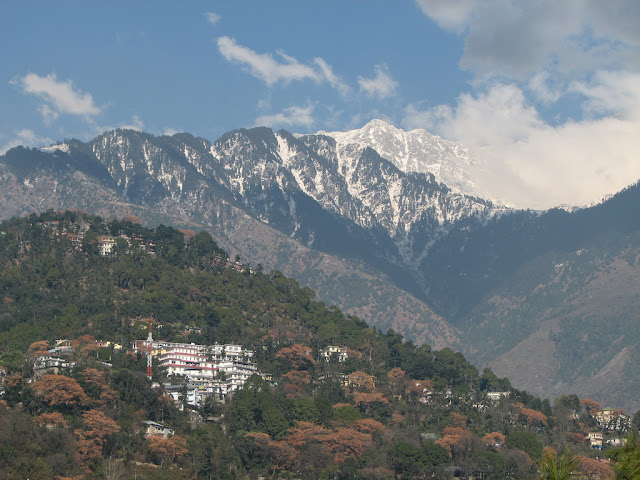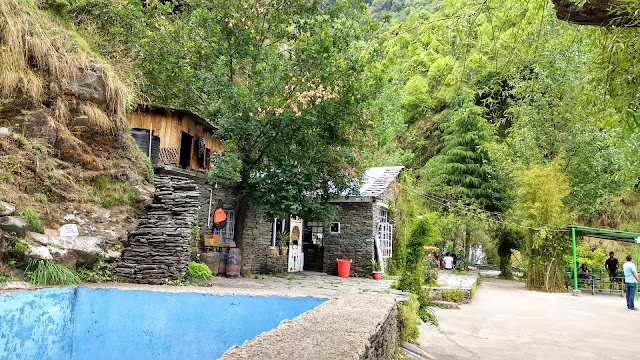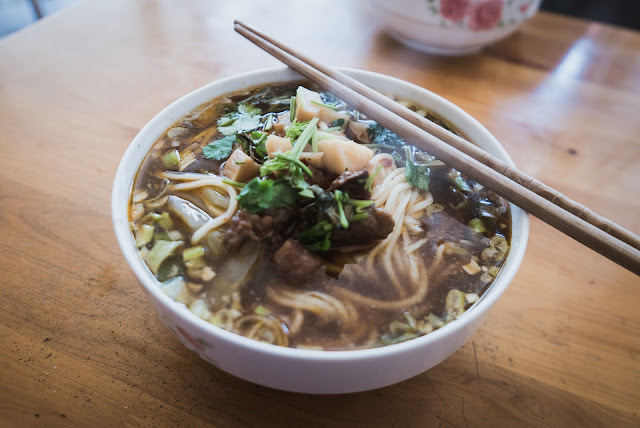Dharamshala, alongside its sister-suburb, Mcleodganj, is perhaps the only place which packs a ton of birr, brought together by the breathtaking Himachal food, local shopping experience, treks, and scintillating mountain-sunrises!
So here is a question - which is that one place which has often been known as the foxy concoction of culture, nature, food, and religion? I bet you won’t find many destinations with a blend so unique, with a brew so solitary, and with an identity so sui generis! Dharamshala is indeed the beating heart of Himachal Pradesh - being home to the bewitching cedar forests on the edge of the Himalayas, this city welcomes lost wanderers and excursionists alike, and surprisingly enough, entertains both the demographics.
A typical view from Dharamshala, with the phenomenal snow-clad Dhauladhars in the backdrop
I travelled to Dharamshala following my weeklong backpacking respite in Bir-Billing. Having already experienced the hippodrome of nature’s bounty and adventure activities brought about by Bir-Billing, I wondered how Dharamshala would add on top of that. Opposite to what Bir-Billing had to offer - serenity, quietude and dead air - Dharamshala is a city abuzz with people, and needless to say, all the shenanigans the urban denizens bring with them. However, even for someone who has a protracted yearning for secluded destinations (myself included), Dharamshala is no less than a charm, because if only you have the perspective to look beyond the congregation and precarious roads, what you see is the stunning Triund Hill, the magnanimous Dhauladars in the distance, the prodigious Bhagsu Nag waterfall, the nobility of Lahesh Caves and the Indrahar pass (for the adventure seekers), and the innumerable small and medium scaled shopping marts and emporiums. Dharamshala, alongside its sister-suburb, Mcleodganj, is perhaps the only place which packs so much birr, brought together by the breathtaking Himachal food, local shopping experience, treks, trails and scintillating mountain-sunrises!
Bhagsu Nag Temple and Waterfall
Dharamshala is primarily divided into two geographies, the city of Dharamshala - home to the famous HPCA Cricket ground, numerous temples and monasteries, and a multitude of shopping options - and then, there’s Mcleodganj, also known as the ‘Little Lhasa’, Dharamshala’s sister-suburb which lies in the lap of the Dhauladars (quite literally!). Mcleodganj is Dharamshala’s antithesis in many aspects - it is quieter, comparatively lesser crowded, and significantly well known amongst backpackers; Dharamshala, on the other hand, is usually packed with tourists, if you would let me draw a line between these two sets of travellers.
View of the renowned HPCA cricket ground from Mcleodganj
Mcleodganj is about 10 kilometre (half an hour distance by bus) from Dharamshala. The twisty hilly road is constantly abuzz with state transport and local buses, which run periodically between Dharamshala and its boondocks. Once you arrive in McLeodganj, the village of Bhagsu, which is well known for the Bhagsu Nag waterfall and the ancient temple, is about 4 kilometre by road from the bus stop. Walk straight down the narrow hilly boulevard and you won’t miss the busy main junction which when crossed, would take you straight to the Bhagsu Nag temple. This temple has an interesting mythological background - it is believed that Nagdevata, the Snake God, got into a battle with King Bhagsu several millenniums ago. The battle was fought because King Bhagsu was accused to have stolen water from the sacred lake of Nagdal. King Bhagsu was vanquished in the battle, and in lieu with numerous Indian mythological stories, later, forgiven. The site was then consecrated as Bhagsu Nag.
The Bhagsu Nag temple is situated immediately alongside the main junction of Mcleodganj. The temple is a typical religious site - huddled with devotees from morning to evening, prayers echoing though every nook and corner, and a multitude of votarients talking a dip in the sacred waters of Bhagsu Nag. Walk straight front through the temple and the path narrows down, runs along a small cliff, and about a kilometre away lies the renowned Bhagsu Nag waterfall.
Bhagsu Nag temple
There are ample secluded spots near the Bhagsu Nag waterfall, just right for those peace seeking wanderers willing to spend hours listening to the music of the gushing waters, staring at the crisp blue skies above, and perhaps, an ukulele besides!
This waterfall is among the most famous attractions of Mcleodganj. Located in the serene village of Bhagsu, the waterfall has a short height of 20m. A little stretch of trekking ahead of the Bhagsu Nag temple takes you to these Falls. The route is well-constructed and is easy to walk - being mostly a concretised trail with the occasional stairs. Among young travellers and adventure-seekers, you will often find the monks and Hindu devotees making their way up to take a shower in the falls. Furthermore, to satiate the hippies that come to this place, a cafe called ‘Shiva Cafe’ is quite famous, located just above the Falls. From this cafe, you can enjoy a panoramic view of the entire Bhagsu Valley - the waterfall beneath, the McLeodganj main junction in the distance, and the famous Triund Hill behind.
The Shiva Cafe lies just a couple minutes from the Waterfall
The crystal-clear waters and sights of the lush green hills make it one of the most beautiful tourist points of Mcleodganj; and without a doubt, there are ample secluded spots near the waterfall, just right for those peace seeking wanderers willing to spend hours listening to the music of the gushing waters, staring at the crisp blue skies above, and perhaps, an ukulele besides!
Trail towards the Bhagsu Nag Waterfall
Triund Hill Trek
Triund hill trek is easily one of the most popular treks in Himachal. The relatively facile trail, the moderate ascent and the spectacular views of the Dhauladhar ranges and the Kangra valley make it perfect for neophyte mountaineers. However, it doesn’t disappoint the trekking doyens either - Triund serves as the base camp for the more demanding expeditions of Lahesh caves and the Indrahar pass.
The Triund Hilltop provide a surreal view of the taller Dhauladhar mountains
Trek to Lahesh caves is about 6 kilometre from Triund hill top, takes around 4-5 hours as the elevation increases (Lahesh caves are at an altitude of 3500 metre, while Triund hill lies at a moderate height of 2800 metre). You can then trek further to Indrahar pass from Lahesh caves which is at 9 kilometre and takes another 6-7 hours, depending on your fitness, of course. Indrahar pass is at an altitude of 4300 metre, so the terrain gets more elevated, air gets thinner, and the ascent gets steep. While the Triund hill trek is easily achievable in a day (to and fro), the Indrahar Pass trek is usually done by experts in 3-4 days.
Being the casual trekker that I am, I ended my journey at Triund, however, I made it a point to spend a night up on the hill top. One can easily find tents to camp on the top for a decent price (around 500 INR for two). The nights at Triund are scintillating, with star lit sky and the all lit up Kangra valley that surely would take your breath away. The views of Dhauladhars washed up in subtle moonlight are so royal, yet intimidating that they are bound to leave you astounded!
The last 3-4 km stretch of the trek, though being steep, is a trail with splendid views showcasing the affluence of India’s beloved North; and once you reach the top of the Triund Hill, what you see in the front is nothing short of Elysium!
The trek to Triund starts from the renowned Mcleodganj main junction, with total distance of 8-9 km one way; but the easier way, and the one I took, is to ride till Galu Devi temple (which is the first check-point) in an auto or taxi. This temple is at the foot of the Triund Hill, where the trek actually commences. Being one of the easier and less risky adventures, no permits are required to scale the Triund Hill. The initial phase of the trail is simple as it is a prairie with stones and a flat path but the last stretch of about an hour or so is a steep ascent, has tiring curves and tests the stamina. The next checkpoints are the two cafes - ‘Magic View Café’ and just a couple hundred metre ahead of it, the ‘Best View Café’. These are about 90 minutes of walk from Galu Devi temple. As the name suggests, both these cafes do not disappoint when it comes to the views of Dhauladhars and the Kangra valley!
Ahead of the cafes, the terrain starts with rhododendron oaks on one side and leads into the dense forest with steep valley on the other. The trail takes you through the beautiful mixed forest of oak, deodar and rhododendron trees and gradually opens up with views of Dhauladhars on your left and the sublime Kangra valley on your right. The last 3-4 km stretch, though being steep, is a trail with splendid views showcasing the affluence of India’s beloved North; and once you reach the top of the Triund Hill, what you see in the front is nothing short of Elysium! They say mountains not only offer the best views of the world below, but the best perspective to experience that world.
The Triund trek is not as demanding as the Rajgundha trek in Bir-Billing, it isn’t even as long as the puissant Kheerganga in Parvati Valley, but it hits the sweet spot between magnitude of difficulty, the perplexity and the rewards you reap when you reach the top!
The trek is not arduous per se - it took me somewhere around 3 hours to reach the hill top, however, thanks to its fame, the route is flooded with people. A word of advice - try starting the trek early morning; the early bird indeed catches the prey - when I started the trek by 6am, there weren’t many trekkers, I had the trail to myself, I could hear the waters gushing in the distance, I could feel the moist dew on the rocks beneath my feet and all in all, it was indeed, magical!
The trail that leads the way to Lahesh caves, and further to Indrahar Pass
Shopping and Food
Dharamshala has a multitude of shops and markets that sell items of Tibetan origins and also commodities that are significant to the Himachali culture. Numerous tourists visit Dharamshala not only because of the magnificent natural beauty surrounding the region but also because of its strong Buddhist and Tibetan influence. Hence, Dharamshala has several shops that sell essential commodities like woollen garments, antique and handicraft items, things connecting to Tibetan culture, and many more. The ‘Divine Buddha Handicrafts’, ‘Kotwali Bazaar’, the ‘Village Boutique’ and just few known places which offer a surreal local shopping experience.
The Kotwali Bazaar is one of the many popular markets in Dharamshala, where you will be able to find not only Tibetan trinkets, but the market is filled with shops that sell gorgeous shawls, sweaters, cardigans, and other items that are essential for daily life, and of course, souvenirs.
Local street shopping is one of the best experiences in Dharamshala
No place is completely delved into if you haven’t tasted the local food. And Dharamshala does not disappoint in this domain either. Some of the best restaurants in Dharamshala are located in McLeodganj. One of the most astounding places here to try the original Tibetan food is the ‘Tibet Kitchen’ located at Jogiwara Road, main junction. It serves a variety of dishes, most of which tend to be appetisers and main courses descending from the Tibetan and Chinese cuisines. The special recipes served here include the Alu Phingsha, fried momos, the thupka, tingmo and the Shapta.
Thupka - The traditional Tibetan royalty
The other place that I would certainly recommend is the Moonlight cafe in Dharamkot. Slightly far by walking by the McLeodganj main junction, this place has an ambiance so unique, so tranquil, that it is perfect to visit this cafe just for the sake of a cup of coffee, a book by your side and a couple hours to spare! In here, try the Tunisian delicacy - Shakshuka, and trust me, you will thank me for this advice!
The Tunisian delicacy - Shakshuka
Dharamshala is perfect if you are craving the ideal mountain vacation - get lost in the quietude of nature, taste the fabulous traditional food, shop in the local emporiums and just roam around in the lap of the surreal Dhauladhars!
Dharamshala and Mcleodganj: The Beating Heart of Himachal; An article by Ankur Deo. Wish to know more about us? Click here!














Comments
Post a Comment